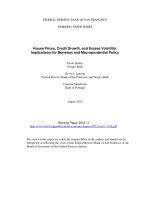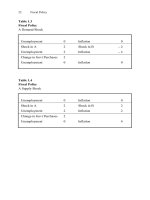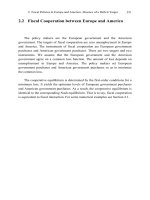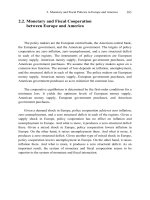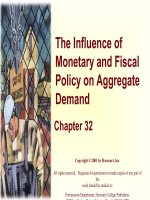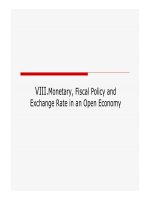Reading 12 monetary and fiscal policy answers
Bạn đang xem bản rút gọn của tài liệu. Xem và tải ngay bản đầy đủ của tài liệu tại đây (723.99 KB, 46 trang )
Question #1 of 100
Question ID: 1377653
Promoting economic growth and price stability are the goals of:
A) fiscal policy, but not monetary policy.
B) monetary policy, but not fiscal policy.
C) both fiscal and monetary policy.
Explanation
Both monetary and fiscal policies are used by policymakers with the goals of maintaining
stable prices and producing positive economic growth.
(Study Session 4, Module 12.1, LOS 12.a)
Question #2 of 100
Question ID: 1377707
The velocity of transactions in an economy has been increasing rapidly for the past seven
years. Over the same time period, the economy has experienced minimal growth in real
output. According to the equation of exchange, inflation over the last seven years has:
A) increased at a rate similar to the growth rate in the money supply.
B) been minimal, consistent with the slow growth in real output.
C) increased more than the growth in the money supply.
Explanation
The equation of exchange is MV = PY. If velocity (V) is increasing faster than real output (Y),
inflation (P) would have to be increasing faster than the money supply (M) to keep the
equation in balance.
For Further Reference:
(Study Session 1, Module 3.2, LOS 3.k)
CFA® Program Curriculum, Volume 2, page 272
CFA® Program Curriculum, Volume 2, page 291
Question #3 of 100
Question ID: 1377650
Attempting to influence economic growth and inflation by changing tax rates and
government spending is best described as:
A) a combination of fiscal and monetary policy.
B) monetary policy.
C) fiscal policy.
Explanation
Fiscal policy refers to actions by a government to influence economic activity through
changes in taxes and government spending.
(Study Session 4, Module 12.1, LOS 12.a)
Question #4 of 100
Question ID: 1377738
Which of the following statements about achieving proper timing in fiscal policy is least
accurate?
A)
Improvements in quantitative methods have made the occurrence of recessions
or expansions quite predictable.
B) Policy errors are inevitable due to unpredictable events.
C)
There is usually a time lag between when a change in policy is needed and when
the need is recognized by policy makers.
Explanation
One problem in achieving proper timing in fiscal policy is the inability to accurately predict
a recession or expansion.
(Study Session 4, Module 12.3, LOS 12.r)
Question #5 of 100
Question ID: 1377716
To determine whether monetary policy is expansionary or contractionary, an analyst should
compare the central bank's policy rate to the:
A) neutral interest rate.
B) target inflation rate.
C) trend rate of real growth.
Explanation
The neutral interest rate is the sum of the trend rate of real economic growth and the
target inflation rate. Monetary policy is expansionary if the policy rate is less than the
neutral interest rate and contractionary if the policy rate is greater than the neutral
interest rate.
(Study Session 4, Module 12.2, LOS 12.m)
Question #6 of 100
Question ID: 1377699
The Federal Reserve has decided to increase the federal funds rate (the interest rate that
banks charge each other for overnight loans). To implement this policy, the Federal Reserve
will most likely:
A) sell government securities in the open market.
B) increase currency exchange rates (cause domestic currency to appreciate).
C) set a lower price on Treasury bills and notes that it is auctioning.
Explanation
Selling government securities on the open market reduces bank reserves and drives up
the federal funds rate. The other two statements are incorrect because the Federal
Reserve does not directly control exchange rates or the prices of government securities.
For Further Reference:
(Study Session 4, Module 12.2, LOS 12.h)
CFA® Program Curriculum, Volume 2, page 291
Question #7 of 100
Question ID: 1377690
If a monetary policy is focused on combating inflation, which open market actions by the
Federal Reserve will most effectively accomplish this?
A) Sell Treasury securities, causing aggregate demand to decrease.
B) Purchase Treasury securities, causing aggregate demand to decrease.
C) Sell Treasury securities, causing aggregate demand to increase.
Explanation
If the Federal Reserve wants to slow inflation, it needs to decrease aggregate demand (i.e.,
business investment, consumer purchases of durable goods, and exports). To accomplish
this, the Federal Reserve could engage in open market sales of Treasury securities.
(Study Session 4, Module 12.2, LOS 12.h)
Question #8 of 100
Question ID: 1377695
Which of the following policy tools is the least likely to be available to the U.S. Federal
Reserve Board?
A) Requiring the banking system to tighten or loosen its credit policies.
B) Buying and selling Treasury securities in the open market.
C) Setting the discount rate at which banks can borrow from the Federal Reserve.
Explanation
The U.S. Federal Reserve can encourage or persuade banks as a whole to tighten or loosen
their credit policies, but it cannot compel them to do so.
(Study Session 4, Module 12.2, LOS 12.h)
Question #9 of 100
Question ID: 1377657
Which of the following is the most accurate definition of the velocity of money? The velocity
of money is the:
A) GDP of a country divided by its price level.
B) money supply of a country divided by its price level.
C) GDP of a country divided by its money supply.
Explanation
Velocity is the average number of times per year each dollar is used to buy goods and
services (velocity = nominal GDP / money). Therefore, the money supply multiplied by
velocity must equal nominal GDP. The equation of exchange must hold with velocity
defined in this way. Letting money supply = M, velocity = V, price = P, and real output = Y,
the equation of exchange may be symbolically expressed as: MV = PY.
(Study Session 4, Module 12.1, LOS 12.c)
Question #10 of 100
Question ID: 1377692
Assume the U.S. economy is undergoing a recession. In its efforts to stimulate the economy
by trying to influence short-term interest rates the Fed is most likely to take which two
actions?
A) Buy Treasury securities and decrease bank reserve requirements.
B) Sell Treasury securities and decrease bank reserve requirements.
C) Sell Treasury securities and increase bank reserve requirements.
Explanation
If the economy is in a recession, the Fed is likely to attempt to decrease short-term
interest rates. Thus, the Fed will buy Treasury securities and decrease bank reserve
requirements.
(Study Session 4, Module 12.2, LOS 12.h)
Question #11 of 100
Question ID: 1377668
Which of the following statements about the relationship between interest rates and the
demand for and supply of money is most accurate? Interest rates affect:
A) the demand for money only.
B) the supply of money only.
C) both the demand for and supply of money.
Explanation
Interest rates only affect the demand for money. With higher interest rates, the
opportunity cost of holding money increases, and people hold less money and more
interest-earning assets. Monetary authorities determine the supply of money. Therefore,
the supply of money is independent of the interest rate.
(Study Session 4, Module 12.1, LOS 12.d)
Question #12 of 100
Question ID: 1377667
If households and firms are holding larger real money balances than they desire:
A) the interest rate is higher than its equilibrium rate.
B)
the central bank must sell securities to absorb the excess money supply and
establish equilibrium.
C) the opportunity cost of holding money balances is likely to increase.
Explanation
If real money balances are larger than households and firms desire, the interest rate
(opportunity cost of holding money balances) is higher than its equilibrium rate.
Households and firms will use their undesired cash to buy securities, bidding up securities
prices and reducing the interest rate until the equilibrium rate is achieved. This market
process does not require any action by the central bank.
(Study Session 4, Module 12.1, LOS 12.d)
Question #13 of 100
Question ID: 1377693
When the Federal Reserve sells government securities on the open market, bank reserves
are:
A)
B)
C)
decreased, which reduces the amount of money banks are able to lend, causing
a decrease in the federal funds rate.
decreased, which reduces the amount of money banks are able to lend, causing
an increase in the federal funds rate.
increased, which increases the amount of money banks are able to lend,
causing a decrease in the federal funds rate.
Explanation
When the Federal Reserve wants to increase the federal funds rate through open market
operations, it sells government securities. Open-market sales reduce bank reserves and
cause the federal funds rate to increase.
(Study Session 4, Module 12.2, LOS 12.h)
Question #14 of 100
Question ID: 1377659
On January 5, the U.S. Federal Reserve (the Fed) bought $10,000,000 of U.S. Treasury
securities in the open market. At the time, the reserve requirement was 25%, and all banks
had zero excess reserves. What is the potential impact of the Fed's purchase on the U.S.
money supply?
A) $10,000,000 increase.
B) $25,000,000 decrease.
C) $40,000,000 increase.
Explanation
Buying securities by the Fed increases the money supply because they are injecting money
into the banking system. The money supply can potentially increase by 1 / 0.25 ×
$10,000,000 = $40,000,000.
(Study Session 4, Module 12.1, LOS 12.c)
Question #15 of 100
Question ID: 1377736
The time it takes for policy makers to enact a fiscal policy action is best described as:
A) legislative lag.
B) implementation lag.
C) action lag.
Explanation
The time it takes for fiscal policy actions to be proposed, approved, and implemented is
referred to as action lag.
(Study Session 4, Module 12.3, LOS 12.r)
Question #16 of 100
Question ID: 1377648
Policies used with the goal of maintaining stable prices and producing economic growth
include:
A) fiscal policy only.
B) both fiscal policy and monetary policy.
C) monetary policy only.
Explanation
Both fiscal and monetary policies are used to maintain stable prices and produce
economic growth. Fiscal policy does so by mechanisms that involve spending and taxation,
and monetary policy uses central bank tools to modify the availability of money and credit.
(Study Session 4, Module 12.1, LOS 12.a)
Question #17 of 100
Question ID: 1377704
What are the three essential qualities an effective central bank should possess?
A) Independence, credibility, and transparency.
B) Credibility, relevance, and reliability.
C) Transparency, independence, and consistency.
Explanation
A central bank that is independent from political interference, possesses credibility, and
exhibits transparency is more likely to achieve its monetary policy objectives than a central
bank that lacks these qualities. The other characteristics listed in the answer choices relate
to financial statements and financial reporting standards.
(Study Session 4, Module 12.2, LOS 12.j)
Question #18 of 100
Question ID: 1377662
Banks choose to hold a higher percentage of deposits as reserves because they believe
general business conditions in the economy are subject to greater uncertainty. If all else is
held constant, what is the most likely impact of this action?
A)
The money supply will increase during a period of inflation, but will decrease if
the economy goes into a recession.
B) The money supply will decrease.
C) There will be no effect on the money supply.
Explanation
If banks choose to hold excess reserves, they will decrease their lending. Less bank
lending will cause the money supply to decrease.
(Study Session 4, Module 12.1, LOS 12.c)
Question #19 of 100
Question ID: 1377746
The government is reducing its spending to balance the budget, while the central bank is
lowering its official policy rate. What will most likely be the combined effect on the economy?
A) The private sector as a percentage of GDP will increase.
B)
The public and private sectors as a percentage of GDP will neither decrease nor
increase.
C) The public sector as a percentage of GDP will increase.
Explanation
The private sector will expand as a percentage of GDP because (1) the public sector will
decrease as a percentage of GDP due to government spending cuts and (2) lower interest
rates should cause the private sector to expand.
(Study Session 4, Module 12.3, LOS 12.t)
Question #20 of 100
Question ID: 1377731
The crowding-out model implies that a:
A)
B)
C)
budget surplus will retard aggregate demand and trigger an economic
downturn.
budget deficit will stimulate aggregate demand and trigger a multiplier effect
which will lead to inflation.
budget deficit will increase the real interest rate and thereby retard private
investment.
Explanation
Increased budget deficits will increase the demand for loanable funds and lead to higher
interest rates and thus lower private investment. Crowding-out implies that an increase in
government spending will choke off private investment and reduce the intended impact of
fiscal policy changes on aggregate demand.
(Study Session 4, Module 12.3, LOS 12.q)
Question #21 of 100
Question ID: 1377681
The primary objective of a central bank is typically to:
A) control inflation.
B) stabilize exchange rates.
C) achieve full employment.
Explanation
Although some central banks have other stated goals including stabilizing exchange rates
and achieving full employment, the primary objective for a central bank is to control
inflation and promote price stability.
(Study Session 4, Module 12.1, LOS 12.f)
Question #22 of 100
Question ID: 1377723
Which of the following statements best explains how automatic stabilizers work? Even
without a change in fiscal policy, automatic stabilizers tend to promote:
A)
B)
C)
a budget surplus during a recession and a budget deficit during an inflationary
expansion.
a budget deficit during a recession but do not promote a budget surplus during
an inflationary expansion.
a budget deficit during a recession and a budget surplus during an inflationary
expansion.
Explanation
Automatic stabilizers such as unemployment compensation, corporate profits tax, and the
progressive income tax run a deficit during a business slowdown but run a surplus during
an economic expansion. Therefore, they automatically implement countercyclical fiscal
policy without the delays associated with policy changes that require legislative action.
(Study Session 4, Module 12.3, LOS 12.o)
Question #23 of 100
Question ID: 1377709
Silvano Jimenez, an analyst at Banco del Rey, is reviewing recent actions taken by the U.S.
Federal Reserve (the Fed) in setting monetary policy. Recently, the Fed decided to increase
the money supply, which has resulted in a decrease in real interest rates. At a staff meeting,
Jimenez brings this matter to the attention of his colleagues and makes the following
statements:
Statement 1: Although the money supply increase has led to a decrease in real interest
rates, we should begin to see U.S. investors decrease their investments abroad and the U.S.
dollar will appreciate in the foreign exchange market.
Statement 2: The Fed's increase in the money supply will increase the amount of imports
into the U.S.
Are Statement 1 and Statement 2 as made by Jimenez CORRECT?
Statement 1
Statement 2
A) Incorrect
Correct
B) Incorrect
Incorrect
C) Correct
Incorrect
Explanation
If the Fed increases the money supply and real interest rates decline, U.S. investors will
seek higher real rates of return abroad and the U.S. dollar will depreciate as the dollar will
be exchanged for foreign currencies in order to buy the foreign investments. Likewise, the
decrease in real interest rates will reduce the inflow of funds from abroad as foreign
investors seek higher rates of return outside the U.S. With a dollar that has depreciated,
U.S. exports should increase, as U.S. products will become cheaper for foreign buyers. As
such, both statements are incorrect.
(Study Session 4, Module 12.2, LOS 12.k)
Question #24 of 100
Unemployment compensation is an example of:
A) an automatic monetary policy stabilizer.
B) a discretionary fiscal policy stabilizer.
C) an automatic fiscal policy stabilizer.
Explanation
Question ID: 1377722
Unemployment compensation automatically rises and falls with the business cycle,
therefore it is an example of an automatic fiscal policy stabilizer.
(Study Session 4, Module 12.3, LOS 12.o)
Question #25 of 100
Question ID: 1377678
According to the Fisher effect, which of the following interest rates includes a premium for
the expected rate of inflation?
A)
B)
C)
Yields on long-term corporate debt, but not yields on short-term government
debt.
Neither yields on short-term government debt nor yields on long-term
corporate debt.
Both yields on short-term government debt and yields on long-term corporate
debt.
Explanation
The Fisher effect holds that all nominal interest rates include a premium for expected
inflation.
(Study Session 4, Module 12.1, LOS 12.e)
Question #26 of 100
Question ID: 1377714
Which of the following is currently the most-used target for central banks?
A) Money supply targeting.
B) Interest rate targeting.
C) Inflation targeting.
Explanation
Inflation targeting is the most-used tool of central banks for making monetary policy
decisions.
(Study Session 4, Module 12.2, LOS 12.l)
Question #27 of 100
Question ID: 1377658
The amount of money a commercial bank has available to lend is known as:
A) fractional reserves.
B) excess reserves.
C) required reserves.
Explanation
Excess reserves are the amount of money a commercial bank has available with which to
make new loans, after depositing its required reserves with the central bank.
(Study Session 4, Module 12.1, LOS 12.c)
Question #28 of 100
Question ID: 1377717
An economy's long-term trend rate of real GDP growth is 3% and the central bank's target
inflation rate is 2%. If the policy rate is 6%, monetary policy is:
A) contractionary.
B) expansionary.
C) neutral.
Explanation
Monetary policy is contractionary when the policy rate is greater than the neutral rate,
which is the sum of the real trend rate of economic growth and the target rate of inflation.
Here, the neutral rate is 3% + 2% = 5% and the policy rate of 6% is greater than the neutral
rate. Monetary policy is expansionary when the policy rate is less than the neutral interest
rate.
(Study Session 4, Module 12.2, LOS 12.m)
Question #29 of 100
Question ID: 1377721
Discretionary fiscal policy refers to:
A) active decisions regarding spending and taxing to affect economic growth.
B) buying or selling securities in the open market to influence interest rates.
C)
government spending programs that counteract the business cycle without the
intervention of policymakers.
Explanation
Discretionary fiscal policy, in contrast to automatic stabilizers, refers to active decisions by
the government to affect economic growth through changes in government spending and
taxation. Buying or selling securities in the open market is an example of monetary policy.
(Study Session 4, Module 12.3, LOS 12.o)
Question #30 of 100
Question ID: 1377676
The three reasons for holding money are most accurately described as:
A) broad money demand, narrow money demand, and transaction demand.
B) narrow money demand, precautionary demand, and speculative demand.
C) transaction demand, precautionary demand, and speculative demand.
Explanation
The three reasons for holding money are: transaction demand, for buying goods and
services; precautionary demand, to meet unforeseen future needs; and speculative
demand, to take advantage of investment opportunities. Narrow money and broad money
refer to measures of money in circulation.
(Study Session 4, Module 12.1, LOS 12.d)
Question #31 of 100
Question ID: 1377663
Which of the following relationships in regard to the quantity theory of money is least
accurate?
A) Money × Velocity = Money Supply × Velocity.
B) Nominal GDP = Money Supply × Velocity = Price × Real Output.
C) Nominal GDP = Price × Money Supply.
Explanation
The quantity theory of money holds that: Money Supply × Velocity = Nominal GDP = Price ×
Real Output.
(Study Session 4, Module 12.1, LOS 12.c)
Question #32 of 100
Question ID: 1377734
Arguments for being concerned with the size of a fiscal deficit relative to GDP least likely
include:
A) a likely need for higher future taxes.
B) higher interest rates due to government borrowing.
C) a high proportion of government debt owed to the country’s citizens.
Explanation
That a government owes its own citizens much of its outstanding debt is an argument
against being concerned about fiscal deficits. Arguments for being concerned about fiscal
deficits include the need for higher future taxes and the potential for government
borrowing to increase interest rates and crowd out private investment.
For Further Reference:
(Study Session 4, Module 12.3, LOS 12.q)
CFA® Program Curriculum, Volume 2, page 316
Question #33 of 100
Question ID: 1377691
Which of the following statements regarding U.S. Federal Reserve open market operations is
least accurate?
A)
B)
If the Fed wants to stimulate the economy, it will sell Treasury securities to
banks.
When the Fed buys Treasury securities, short-term interest rates will generally
decrease.
C) When the Fed sells Treasury securities, excess reserves decrease.
Explanation
If the Fed intends to stimulate the economy, they will buy, not sell, Treasury securities.
Buying Treasury securities injects reserves into the banking system.
(Study Session 4, Module 12.2, LOS 12.h)
Question #34 of 100
Question ID: 1377660
When additional or excess reserves are injected into the U.S. banking system, the money
supply can potentially increase by an amount equal to the additional excess reserves
multiplied by which of the following?
A) Reciprocal of one minus the required reserve ratio.
B) Reciprocal of the required reserve ratio.
C) Required reserve ratio.
Explanation
The potential deposit expansion multiplier = 1 / (required reserve ratio)
The potential increase in the money supply = potential deposit expansion multiplier ×
increase in excess reserves
(Study Session 4, Module 12.1, LOS 12.c)
Question #35 of 100
Question ID: 1377672
The demand for money curve represents the relationship between the quantity of money
demanded and:
A) the price level.
B) the quantity of money supplied.
C) short-term interest rates.
Explanation
The demand for money curve represents the relationship between short-term interest
rates and the quantity of real money that households and firms demand to hold.
(Study Session 4, Module 12.1, LOS 12.d)
Question #36 of 100
Question ID: 1377689
An individual has just purchased a home by taking on a 30-year fixed rate mortgage. She
would benefit most from this transaction if future inflation rates are:
A) higher than anticipated.
B) exactly as anticipated.
C) lower than anticipated.
Explanation
Inflation that is higher than anticipated will result in a transfer of wealth from lenders to
borrowers.
(Study Session 4, Module 12.1, LOS 12.g)
Question #37 of 100
Question ID: 1377683
A country is experiencing a core inflation rate of 7% during a recessionary period of real GDP
growth. If the central bank has a single mandate to achieve price stability and uses inflation
targeting with an acceptable range of zero to 4%, its monetary policy response is most likely
to decrease:
A) GDP growth in the short run.
B) short-term interest rates.
C) the foreign exchange value of the country’s currency.
Explanation
If the central bank has a price stability mandate, it will most likely respond to the abovetarget inflation rate by decreasing the money supply, even though GDP growth is in a
recessionary phase. Decreasing the money supply will result in higher short-term interest
rates and appreciation of the currency, but will likely cause GDP growth to decrease
further in the short run.
(Study Session 4, Module 12.1, LOS 12.f)
Question #38 of 100
Question ID: 1377651
A distinction between fiscal policy and monetary policy is that fiscal policy:
A)
concerns taxes and government spending, while monetary policy concerns the
money supply.
B) is typically expansionary, while monetary policy is typically contractionary.
C)
is aimed at promoting economic growth, while monetary policy is aimed at
promoting price stability.
Explanation
The distinction between fiscal and monetary policy is that a country's government
determines fiscal policy through taxes and spending, but its central bank determines
monetary policy by controlling the money supply. Both fiscal and monetary policy can be
used to promote economic growth and price stability. Either fiscal policy or monetary
policy can be expansionary or contractionary.
(Study Session 4, Module 12.1, LOS 12.a)
Question #39 of 100
Question ID: 1377728
Assuming the economy currently is experiencing high inflation, an example of appropriate
discretionary fiscal policy is:
A) increase the federal funds target rate.
B) reduce government expenditures on major government construction projects.
C) reduce the money supply.
Explanation
Discretionary fiscal policy refers to the federal government's decisions regarding
government spending and taxing. A reduction in government spending on major
government construction projects is likely to lead to a reduction in aggregate demand and
less pressure on prices, reducing inflation.
(Study Session 4, Module 12.3, LOS 12.p)
Question #40 of 100
Question ID: 1377649
Monetary policy is most accurately described as actions that influence economic activity by
increasing or decreasing:
A) currency exchange rates.
B) the supply of money and credit.
C) tax rates on income and consumption.
Explanation
Monetary policy attempts to influence economic growth and inflation by increasing or
decreasing the money supply and the availability of credit in the economy. Taxes and
government spending are tools of fiscal policy. Monetary and fiscal policy can both
influence currency exchange rates, but this is not typically their primary goal or tool.
(Study Session 4, Module 12.1, LOS 12.a)
Question #41 of 100
Question ID: 1377710
Which of the following is the most likely result of a central bank's shift to an expansionary
monetary policy?
A) Domestic currency appreciates.
B) Exports increase.
C) Interest rates increase.
Explanation
Expansionary monetary policy decreases interest rates. This should cause the domestic
currency to depreciate, which should increase foreign demand for the country's exports.
(Study Session 4, Module 12.2, LOS 12.k)
Question #42 of 100
Question ID: 1377712
If a central bank implements an exchange rate targeting policy successfully, the country's
inflation rate is most likely to be:
A) less than that of the target currency.
B) greater than that of the target currency.
C) the same as that of the target currency.
Explanation
Successful exchange rate targeting should result in the same inflation rate in the targeting
country as in the country of the target currency.
(Study Session 4, Module 12.2, LOS 12.l)
Question #43 of 100
Question ID: 1377735
The time it takes for a fiscal policy action to affect the economy is best described as:
A) action lag.
B) impact lag.
C) recognition lag.
Explanation
The time it takes for a fiscal policy action, once implemented, to have its effect on the
economy is referred to as impact lag. Recognition lag is the time it takes policymakers to
realize a fiscal policy response is needed. Action lag is the time it takes policymakers to
discuss, enact, and implement fiscal policy measures.
(Study Session 4, Module 12.3, LOS 12.r)
Question #44 of 100
Question ID: 1377661
If a bank receives a deposit of $1 million in cash which has been held outside the banking
system and the reserve requirement is 10%, the maximum increase in the money supply
that could result is:
A) $100,000.
B) $900,000.
C) $10,000,000.
Explanation
The maximum increase in the money supply from a fractional reserve banking system is
the money multiplier (1 / reserve requirement) times the amount of a new deposit of cash.
1/0.10 × $1 million = $10 million.
(Study Session 4, Module 12.1, LOS 12.c)
Question #45 of 100
Question ID: 1377655
Money functions as a store of value because:
A) money is accepted as the form of payment for goods.
B)
money received for work or goods can be saved to purchase goods or services
in the future.
C) prices of goods and services are expressed in units of money.
Explanation
Money has three primary functions: it provides a store of value because money received
for work or goods can be saved for future consumption; it serves as a unit of account
because prices of all goods and services are expressed in units of money; and it serves as
a medium of exchange because money is accepted as a form a payment.
(Study Session 4, Module 12.1, LOS 12.b)
Question #46 of 100
Question ID: 1377666
Assume that the required reserve ratio is 20%, and banks currently have no excess reserves.
If the Federal Reserve then buys $100 million of Treasury bills from the banks, the money
supply could potentially increase by:
A) $100 million.
B) $20 million.
C) $500 million.
Explanation
1
Potential expansion multiplier =
required reserve ratio
(100)(5) = 500
For Further Reference:
(Study Session 4, Module 12.1, LOS 12.c)
CFA® Program Curriculum, Volume 2, page 272
Question #47 of 100
1
=
0.2
= 5
Question #47 of 100
Question ID: 1377720
Which of the following conditions is difficult for monetary policy to address because a
central bank cannot reduce its nominal policy rate much below zero?
A) Deflation.
B) Inflation.
C) Stagflation.
Explanation
Deflation is difficult for central banks to address when policy rates cannot be lowered any
further. Inflation can be addressed by contractionary monetary policy. Stagflation is
difficult to address because monetary policy cannot pursue higher growth and lower
inflation at the same time.
(Study Session 4, Module 12.2, LOS 12.n)
Question #48 of 100
Question ID: 1377696
Central banks pursuing expansionary policies may:
A) decrease the policy rate and make open market purchases of securities.
B) decrease the policy rate and make open market sales of securities.
C) increase the policy rate and make open market purchases of securities.
Explanation
Decreasing the policy rate, decreasing reserve requirements, and purchasing securities in
the open market are expansionary monetary policy actions.
(Study Session 4, Module 12.2, LOS 12.h)
Question #49 of 100
Question ID: 1377743
The government budget deficit of Country M is increasing. At the same time, the government
budget surplus of Country N is decreasing. Are the fiscal policies of these countries
expansionary or contractionary?
A) Both are contractionary.
B) Both are expansionary.
C) One is expansionary and one is contractionary.
Explanation
Expansionary fiscal policy increases a budget deficit or decreases a budget surplus.
Contractionary fiscal policy decreases a budget deficit or increases a budget surplus.
(Study Session 4, Module 12.3, LOS 12.s)
Question #50 of 100
Question ID: 1377680
The Fisher effect describes the relationship between:
A) expected and unexpected inflation.
B) money supply growth and actual inflation.
C) nominal and real interest rates.
Explanation
The Fisher effect states that a nominal interest rate is equal to a real interest rate plus the
expected rate of inflation.
(Study Session 4, Module 12.1, LOS 12.e)
Question #51 of 100
Question ID: 1377682
If a bank needs to borrow funds from the Federal Reserve to fund a temporary shortage in
reserves, it would borrow funds at the:
A) discount rate.
B) federal funds rate.
C) prime rate.
Explanation
Banks are able to borrow from the Fed at the discount rate. The federal funds rate is the
interest rate banks charge other banks to borrow reserves from other banks. The prime
rate is the rate that commercial banks charge their best customers.
(Study Session 4, Module 12.1, LOS 12.f)
Question #52 of 100
Question ID: 1377664
Assume the Federal Reserve purchases $1 billion of securities in the open market. What is
the maximum increase in the money supply that can result from this action, if the required
reserve ratio is 15%?
A) $850 million.
B) $1.00 billion.
C) $6.67 billion.
Explanation
The money multiplier is 1 / 0.15 = 6.67, so the open market purchase can increase the
money supply by a maximum of $6.67 billion.
(Study Session 4, Module 12.1, LOS 12.c)
Question #53 of 100
Question ID: 1377694
If the Federal Reserve wishes to lower market interest rates without changing the discount
rate, it can:
A) buy Treasury securities.
B) increase bank reserve requirements.
C) raise the yield on Treasury securities.
Explanation
Buying Treasury securities pumps money into the economy, lowering interest rates.
Higher reserve requirements will restrict the money supply, causing rates to rise. The
Federal Reserve has no direct control over the yield on existing Treasury securities.
(Study Session 4, Module 12.2, LOS 12.h)
Question #54 of 100
Question ID: 1377700
If the U.S. Federal Reserve decides to decrease the money supply, which of the following is
most likely to occur in the short run?
A) An increase in the velocity of money similar to decrease in the money supply.
B) An increase in the real rate of interest.
C) A decrease in the unemployment rate.
Explanation
If the U.S. Federal Reserve decreases the money supply, an increase in nominal and real
interest rates will occur. Higher real rates will cause businesses to invest less, which will
cause the unemployment rate to increase. Furthermore, households will decrease
purchases of durable goods, automobiles, and other items that are typically financed at
short-term rates. This will decrease aggregate demand. The decrease in aggregate
demand and expenditures will cause incomes to go down, which further decreases
consumption and investment. Moreover, this decrease in aggregate demand will decrease
real GDP and the price level in the short run and the long run.
(Study Session 4, Module 12.2, LOS 12.i)
Question #55 of 100
Question ID: 1377719
Which of the following statements regarding the monetary policy transmission mechanism is
most accurate?
A)
B)
Central banks can control short-term interest rates directly, but long-term
interest rates are beyond their control.
Central banks can control long-term interest rates directly because decisions by
consumers and businesses are based on these rates.
Central banks can control short-term interest rates by increasing the money
C) supply to increase interest rates or by decreasing the money supply to decrease
interest rates.
Explanation
Central banks can control short-term interest rates directly. However, the decisions of
consumers and businesses are based on long-term interest rates, which are beyond the
control of central banks. Increasing the money supply will decrease interest rates and
decreasing the money supply will increase interest rates.
(Study Session 4, Module 12.2, LOS 12.n)
